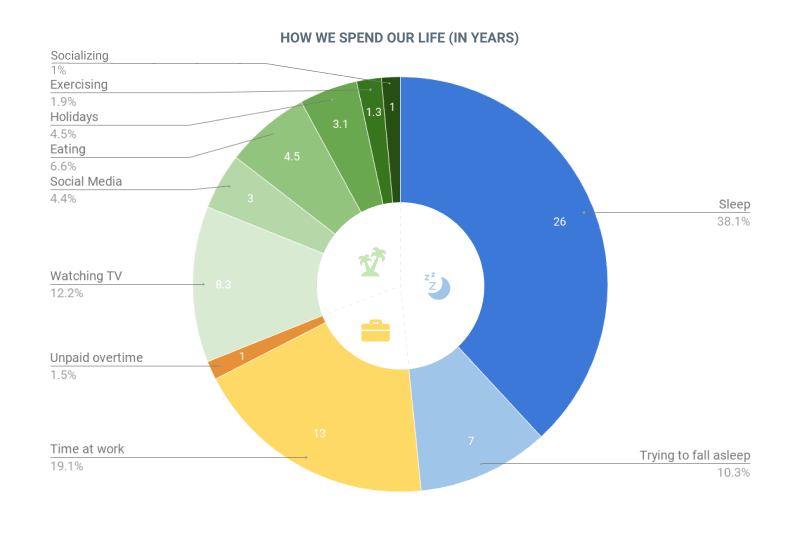
Support is a job of constant context-switching. From working in the inbox to helping your coworkers, hopping on calls, and maybe even fighting fires or large scale issues, it can feel like you are constantly taking off one hat and putting on another. According to Inc., the estimated cost of lost productivity due to multitasking is $450 billion and, on an individual level they are just as bad:

Beyond being tiresome, context-switching and the shifting between roles can actually impact your IQ. That’s bonkers! So, what are some ways that you can stay your most-productive self while still working a role that is, by necessity, filled with distractions? We’ve got some great tips.
1. Track your time in and out of the inbox
Have you ever looked at your watch only to wonder to yourself “Where did the day go?” If you’re busy, chances are most days fly by, leaving you to feel like you’ve used up a lot of time with little to show for it at the end. Tracking your time can give you better insights into where all of your time is going and allows you to visualize trends in your own work patterns. Check out this breakdown of how the average human spends their lifetime:

While most of us don’t have a tool that will break our time spent down into this level of granularity, if you implement functionality like RoundPie, you’ll definitely get closer. These tools allow you to see your most used applications on both your mobile device and computer. Beyond that, it plots out a graph of how productive you are at different parts of the day. Combine those data-heavy insights by taking a survey at the end of each day and answering how productive you felt like you were.
Over time, you’ll start to see correlations: are you most productive when you have an hour of time blocked off to just focus on your helpdesk inbox and replies in the morning? Do you prefer a less meeting-heavy day in order to do your best work? Tracking your time helps you recognize and build better work habits while also keeping your thumb on the pulse of how much time you’re spending on tickets versus your other important work. It can also help your manager with staffing appropriately: if everyone on your team is spending most of their time working on social media support, it may be time to hire someone to work specifically on that task alone.
2. Take time out of the queue
It might sound counterintuitive, but the top 10% of productive employees work about 52 minutes before they take a break. When they do take a break, they end up being about 17 minutes long—if you do the math, that’s about 30% of their workday! It sounds like a lot of time, but when those employees are working, they are giving their best and providing much higher output than their coworkers that don’t take as many breaks.
In order to be your best, most productive self, schedule yourself some time away from the keyboard and the inbox to recalibrate throughout the day. If you’re in support and are often at the beck and call of your coworkers or other teams within your company, use your calendar to block off chunks of time for yourself to get away: that way, no one can accidentally book you on a call, or put you in a meeting. Better yet, beyond your breaks: start to schedule regular, planned blocks of time where you can work on outside projects like documentation, or new processes to elevate your support team and maximize your time out of the queue.
3. Take 25 minutes maximum per ticket
If you aren’t already familiar with how the Pomodoro technique works: you set a timer for 25 minutes and go heads down; the period of time is called a Pomodoro. After the timer goes off, you take a 5-minute break and then return to do another 25 minutes of work. After four or five Pomodoros, you take a longer break (usually around fifteen to twenty minutes).
These time limits are incredibly helpful because they signify to your brain that you are not going to be heads down forever, and give you a set timeline for your focus. Imagine it like you were a runner: if you didn’t know much longer you had to go on your run, you might not run as fast as you would if you knew you only had a little bit left. RoundPie offers a pomodoro timer that allows you to time yourself in a number of business productivity apps, like Trello, Basecamp, and Jira. You can also use standalone timers to do Pomodoros in your support helpdesk—when working on particularly challenging tickets, allow yourself 25 minutes of focus time before you take a break.
While Pomodoro is great because it helps encourage you to get into a hyper-productive heads-down space, it’s also excellent because it helps you have a better understanding of your time. For example, you know how much you are able to accomplish in a day, and can be better at setting and communicating deadlines than you were before. Instead of committing to something and tell yourself that you’ll get it done in a day, you’ll be able to look at it in terms of Pomodoros and the amount of work you already have to accomplish. That provides you much more realistic and contextual understanding of your ability to output and get work done.
4. Find quiet
Many of us are on social media. Whenever we have a moment of downtime, we are drawn to Twitter, Facebook or any other tool where we can go and have an endless stream of things to distract us. Furthermore, lots of us have a desktop and mobile notifications turned on, meaning that we get notified anytime something new is available. This is particularly problematic when, in support, you’re expected to have eyes on everything at once. You probably have notifications for your notifications, just to make sure you don’t miss any potentially important updates.
The average employee is interrupted 56 times a day, and spends about two hours recovering from those interruptions, according to Atlassian. Finding any way that you can to reduce those interruptions will greatly increase your productivity levels: turn off your notifications, set up Do Not Disturb on your team’s messaging tool, and let yourself focus during times of productive work. Save Facebook, cat memes, and connecting with friends for your break times.
5. Make lists
At the beginning of each workday, when you’re putting together your plans for the day, create actual guidelines for what you want to accomplish and finish. For each meeting that you have scheduled, create an outcome that you’d like to have achieved. For every chunk of “heads down” time, list one thing that you’d like to have done by the end of it. If you’re going to be primarily in the queue, set a goal for how many tickets you would like to complete while maintaining a high level of CSAT survey satisfaction. Creating a concrete list of action items helps start to get you better organized and prepared to get things done.
According to I Done This, many people just think about to-do lists as a reminder, rather than an actual plan on how to get things done: the average person has about 150 tasks that they need to do floating around in their head! By breaking down what each part of your day is going to result in, you give yourself guidelines for where to focus your time and also have a set of checks and balances to see if all of those meetings are really necessary. If you can’t think of the one thing that you want to have accomplished after the meeting, you probably shouldn't be having it.
Conclusion
Productivity isn’t something that you can just wave a magic wand and have control over. A lot of it is about the practice and putting rituals in place in your day-to-day life. By starting to add a bit more structure in your day and taking some time to analyze how your best days begin and usually flow, you set yourself up for more success moving forward. This is especially true if you work a usually-chaotic job, like support.
Make time to study your practices and find out what works best for you, then build that behavior into your workday. Make lists to keep yourself accountable, quiet down your workspace, and give yourself both the appropriate amounts of heads-down time, balanced with the right amount of breaks. After a bit more mindfulness, you’ll find both your productivity and your happiness skyrocketing!
About the author:
Yaakov Karda is the co-founder of Chatra.io and a slow coffee enthusiast. When not brewing or working on the startup, he helps his wife with a jewelry business or explores Tel-Aviv on a bicycle.
What would you like to know and what would be the best way to share this information to you? What is the best tips & tricks, what workaround do you use? We'd really appreciate your insight on these ones to make our integrations better, more productive and much more efficient. Comments, tweets are always welcome.